A workshop on Corporate Social Responsibility (CSR) for Agricultural Development was held on Nov 19- 20, 2018 at National Institute of Agricultural Extension Management (MANAGE), Hyderabad. N Balasubramani and A Vincent reflect on this workshop.
CONTEXT
Investment is key to any economic activity. In agriculture, capital is necessary for timely application of inputs, undertaking timely field operations, increasing productivity and realising better price for farm produce. In India, farmers face various problems related to inputs, credit, advisory services and infrastructure due to poor investment in agriculture. Hence, there is a need to promote investment in this sector, which can be accomplished through Corporate Social Responsibility (CSR).
Section 135 of Companies Act, 2013, makes it mandatory for a company (having net worth of Rupees 500 crore or more, or turnover exceeding Rupees 1,000 crore or a net profit of Rupees 5 crore or more), to spend at least 2% of its average net profit made during preceding three financial years. Less than 3% of CSR funds are spent in the agriculture; most of it is spent in education, health and livelihoods sectors.CSR funds can be channelled to agriculture and allied sectors by sensitizing corporates about the importance of such contributions. In this context, a two-day workshop was organized on Corporate Social Responsibility for Agricultural Development at MANAGE in collaboration with Birla Institute of Management Technology (BIMTECH) during 19-20 November 2018. The workshop was held to share and discuss recent updates on the policy framework of CSR, good practices in CSR projects, to comprehend partnership dynamics, map impactful projects implemented by corporates and upscaling.
The workshop was attended by scientists from ICRISAT, agricultural universities, Krishi Vigyan Kendras (KVKs), officials from agriculture and allied departments, and 25 senior corporate representatives including some from India’s noted brands like ONGC, Reliance Foundation, Tata Trusts, JSW Foundation, DS Group, ASCI, Sattva, JK Tyre & Industries Ltd., Ambuja Cement Foundation, The Goat Trust, Odisha Power Generation Corporation Ltd. (OPGC), Tanager and Dr. Reddy’s Foundation.
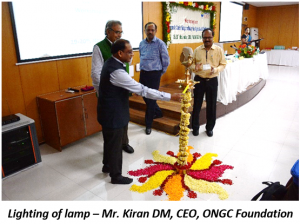 It was noted from the workshop that corporates spend a large amount of CSR funds in Natural Resource Management (NRM), technological innovations, extension advisory models, institutional and market innovations. Here, this meeting note helps understand the determinants for sustainability of CSR interventions and demonstrates successful methods adopted by the corporate sector. Further, this meeting note elucidates gaps in convergence, knowledge management, research cum extension system, policy and provides suggestions to overcome the same.
It was noted from the workshop that corporates spend a large amount of CSR funds in Natural Resource Management (NRM), technological innovations, extension advisory models, institutional and market innovations. Here, this meeting note helps understand the determinants for sustainability of CSR interventions and demonstrates successful methods adopted by the corporate sector. Further, this meeting note elucidates gaps in convergence, knowledge management, research cum extension system, policy and provides suggestions to overcome the same.
“Economically weak states including Bihar, West Bengal, Odisha and states in the North East get the least amount of CSR funds while richer states including Maharashtra, Gujarat and Karnataka get the most of it. Within states, a city like Mumbai gets more CSR funds compared to weaker regions like Vidarbha” – Prof. NN Sharma, BHIMTECH
Natural Resource Management (NRM)
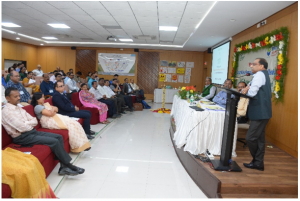 It emerged during the course of discussions that out of all the CSR projects in agricultural sector, corporates have mainly focused on Natural Resource Management (NRM) through Watershed Development. This may be attributed to high dependence of agriculture on rain, leaving farmers vulnerable to the vagaries of climate change.
It emerged during the course of discussions that out of all the CSR projects in agricultural sector, corporates have mainly focused on Natural Resource Management (NRM) through Watershed Development. This may be attributed to high dependence of agriculture on rain, leaving farmers vulnerable to the vagaries of climate change.
The participants highlighted various success stories of watershed development initiatives undertaken by them under CSR. For example, it was observed that Parasi-Sindh Watershed, Jhansi and Bhujal Water Sustainability program (Coca-Cola foundation and ICRISAT) helped farmers in bringing fallow lands to cultivation. They also helped increase crop yield ( 14-22%), enhance family income ( 2-3 times),raise ground water table (2-2.5 m), increase cropping intensity (more than 50 %), increase productivity of dairy animals (up to 3 %), improve overall soil health status and more.
Partnerships with corporate including Asian Paints, Coca Cola and M & M, to name a few, was seen as one of the driving factors in the success of ICRISAT’s initiatives. Additionally, involvement of multiple stakeholders contributed to the sustainability of watershed projects implemented by ICRISAT in Bundelkhand and Mahabubnagar (Telangana). It was also highlighted during discussions that the success of ‘Farmer-Centric Integrated Watershed Management for Improving Rural Livelihoods’ programme, implemented in Mahabubnagar by ICRISAT, can be attributed to multifaceted partnerships i.e. financial partner (Rural Electrification Corporation Ltd), knowledge/information partner (ICRISAT), extension advisory service partner (Department of Agriculture), technology cum capacity/skill partner (District Water Management Agency, Watershed Committee and BAIF, an NGO). Fostering convergence among various players and forging a relevant partnership is therefore important to create a desirable impact in agricultural development.
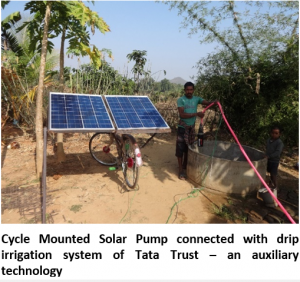 Similarly, the watershed management programme and water harvesting structures (Gabion, Loose Stone Check Dam, Contour Stone Bunds etc.) of Dharmpal and Satyapal Ltd. (DS Group Ltd.) in Deepawas Gram Panchayat, Mokalwas (Sikar district), Gogunda Block (Udaipur district) and Karauli district in Rajasthan have improved livelihoods of farmers. It is to be noted that the efforts undertaken by DS Group in identification of indigenous knowledge and ensuring community ownership have been the most important determinants of the programme’s success. It was further observed that convergence with local NGOs is equally important for mobilising, monitoring and ensuring sustainability of the project. In the same way, experience from watershed models of JSW indicates how synergic support from ICRISAT & NABARD (technical supporters), state governments (policy enablers) and local community can play a major role in effective implementation of a project.
Similarly, the watershed management programme and water harvesting structures (Gabion, Loose Stone Check Dam, Contour Stone Bunds etc.) of Dharmpal and Satyapal Ltd. (DS Group Ltd.) in Deepawas Gram Panchayat, Mokalwas (Sikar district), Gogunda Block (Udaipur district) and Karauli district in Rajasthan have improved livelihoods of farmers. It is to be noted that the efforts undertaken by DS Group in identification of indigenous knowledge and ensuring community ownership have been the most important determinants of the programme’s success. It was further observed that convergence with local NGOs is equally important for mobilising, monitoring and ensuring sustainability of the project. In the same way, experience from watershed models of JSW indicates how synergic support from ICRISAT & NABARD (technical supporters), state governments (policy enablers) and local community can play a major role in effective implementation of a project.
Technological Innovation
It was heartening to learn during the workshop about corporates making significant CSR investments in technological innovations. Some of these include the ‘Half-Acre Vegetable’ model of Tata Trusts (Odisha), e-sustainable solution of Royal Sahakari Samiti, ‘Detox’ soil amelioration measures (bio-fertiliser) of NCS Green Earth Ltd (pan India), aQysta (Barsha Hydroelectricity Pumps-developing countries) of Sattva, bio-fertiliser/traditional processing of tamarind by MSSRF (pan-India) and Diversion Based Irrigation (DBI) of Madhyam Foundation (Odisha).
These innovative technologies coupled with creation of support systems such as development of infrastructure (establishment of lab, plant and machinery facilities by NCS Green Earth Ltd), auxiliary technologies (cycle mounted solar pumping system, syphoned automated drips connected to solar pumps and low cost bamboo-lined wells dug by Tata Trusts), promotion of FPOs/NGOs/SHGs for integrated payment and usage, information dissemination through various media (magazines, radio and television, bulk SMS, agricultural fairs, in-person training by Sattva), regional partnership, linkages with potential farmers and markets (Sattva), innovative marketing process, capacity building of stakeholders including farmers (technical, managerial and more), team building, B2B and B2C activities followed by service customization based on client requirements, have led to tapping of technology’s full potential to yield adoption and impact
Neo Extension advisory services models
Workshop discussions showed varied extension advisory service strategies adopted by corporates to reach out to farmers. ‘Commodity-based lead farmer’ is one the effective extension strategies of Dr. Reddy’s Foundation, which aims to lower the ratio of farmers to extension workers from 1000:1 to 200:1 and complement extension advisory services of field functionaries by engaging around three lead farmers for 40 to 50 farmers. It was evident from the presentation of Dr. Reddy’s Foundation that a well-established programme management structure, starting from steering committee through technical partner/sector specific resource pool, and implementation team is key to effective operation of the lead farmer concept. Likewise, in allied sectors, CSR fund has been spent on individual method of extension services. For example, the ‘Pashu Nurses’ (community livestock managers) who were trained by the Goat Trust have become vital sources for livestock extension cum clinical services including artificial insemination.
“Let us think as a community and strive towards bringing back the pride of the farming community and dignity to the farming profession through CSR” – Kiran DM, CEO, ONGC Foundation
It is understood from Goat Trust that a chain of trained extension personnel from top to field level can sustain extension services. The service model involves a pool of Community Livestock Managers (CLM) trained at Livestock Business Centres (one LBC per 100 villages), entrusted to train the field-level Village Livestock Nurse (VLN) for effective transfer of technical knowhow of livestock management. Moreover, community leadership, community contribution, social voluntarism and skill orientation by Agriculture Skill Council of India (ASCI) are promoted by corporates to improve extension services and enhance the adoption of technologies by farming communities.
Table 1: A few example of new extension advisory models
| New extension advisory model | Corporate | Working areas | Impact |
| Commodity-based lead farmer | Dr. Reddy’s Foundation | Pan India | Formed about 1,400 lead farmers across 500 villages and reached out to 10,000 farmers (as of 2018).
Capsule training to lead farmers helps them access scientific practices of different crops and disseminate them to their clientele. Lead farmers are linked to Agriculture Technology Management Agency (ATMA), Agriculture and Allied departments to get information about various schemes and programmes of these departments, thereby benefiting the farmers. |
| Village Livestock Nurse | The Goat Trust | Pan India | About 40,000 women farmers have been organised into a collective.
Women members of the collective are trained to become Village Livestock Nurses. |
Institutional innovation
The workshop highlighted successful institutional innovations undertaken by corporates in agriculture and allied sectors. Though most corporates followed a group approach as a strategy to link farmers with traders and consumers, Odisha Power Generation Corporation Ltd. (OPGC) and MicroX Foundation spent their CSR funds on the formation of commodity groups or Farmers Producer Organisations (FPOs).The commodity group on onion created by MicroX Foundation helped onion farmers in Lodhipur village in Bihar to link directly with traders. It was observed that MicroX Foundation also considered frequent training, weather alerts and other advisory services through SMS as crucial for quality onion production and to ensure remunerative returns to farmers. In the case of OPGC, farmers (mostly women) were grouped for effective backward and forward linkages. Structured capacity building, provision of agri-inputs and business development plans through technical and financial assistance have been instrumental in sustaining the FPO. As a result, OPGC-promoted FPO has emerged as the biggest entity of producers in Odisha, comprising 1,047 members with a producer stake of Rupees 5.23 lakh at a membership fee of Rupees 0.52 lakh. It is obvious that most corporate assess supply and demand in the market before investing CSR funds in agricultural sector.
Market innovations of corporates showcased at the workshop include a concept of backward calculation in mint marketing that was implemented in Barabanki, Uttar Pradesh, by Tanagar. Called Beej Se Bazar Tak (seed to market), it provides effective market facilities to more than 22,000 farmers. Promotion of FPOs and women centric groups, around 800 of them, were the enabling factors in effective marketing of mint.
Key Observations
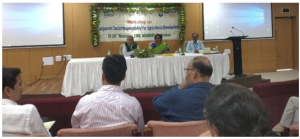 The workshop has been an eye-opener for attendees including policymakers, agricultural scientists, officials from agriculture and allied departments. It underscored the significance of CSR funds in accelerating agricultural growth. Moreover, the discussions during the workshop highlighted challenges that can be addressed if CSR funds are efficiently invested, with convergence, in agriculture. Corporates also realized that agriculture and allied sectors have a huge potential for investment under CSR. However, it is evident that most initiatives of corporates are isolated, sporadic and scattered. In the same way, utilization of CSR funds is minimal in many areas of agriculture including input management, post-harvest management, value addition/technology, marketing, Information and Communication Technology (ICTs), among others.
The workshop has been an eye-opener for attendees including policymakers, agricultural scientists, officials from agriculture and allied departments. It underscored the significance of CSR funds in accelerating agricultural growth. Moreover, the discussions during the workshop highlighted challenges that can be addressed if CSR funds are efficiently invested, with convergence, in agriculture. Corporates also realized that agriculture and allied sectors have a huge potential for investment under CSR. However, it is evident that most initiatives of corporates are isolated, sporadic and scattered. In the same way, utilization of CSR funds is minimal in many areas of agriculture including input management, post-harvest management, value addition/technology, marketing, Information and Communication Technology (ICTs), among others.
The workshop discussions also revealed inadequate linkages between corporates and public institutions like State Agricultural Universities (SAUs), Krishi Vigyan Kendras (KVKs), research organizations and policymakers. Moreover, most CSR innovations and scalable technologies have not come to foreowing to limited documentation and identification of their impact in agriculture and rural advisory services.
WAY FORWARD
Partnership/convergence
- Corporates may collaborate with frontline extension systems such as the state, district, block and village-level extension bodies like SAMETI, Department of Agriculture and allied departments, and ATMA for effective utilisation of CSR funds and enhanced outreach.
- Corporates may work jointly with research and extension organizations (ICAR organisations, agriculture, horticulture and veterinary universities, ATMA/KVKs) to address field-level technological and extension bottlenecks to increasing farmers’ production and incomes.
- The process and institutional mechanism of CSR interventions in agriculture should be documented for replication and upscaling.
- Public-Private Partnership (PPP) can be promoted to upscale technological innovations of corporates like the Half-Acre model, aQysta, Detox, e-sustainable solution and Project on Onion.
- Public extension systems can emulate some of the extension advisory methodologies of corporates like Commodity-based Lead Farmer, Pashu Nurse, Community Livestock Manager, community leaders and social volunteers.
Policy and governance
- A special mention of agriculture may be made in Schedule VII of Companies Act, 2013, which will attract corporates to invest more in agriculture.
- The National Institute of Agricultural Extension Management (MANAGE) can mediate between corporates and implementing agencies (such as public institutions and NGOs). MANAGE may receive funds from corporates and project proposals from implementing agencies, scrutinise and select suitable proposals for effective utilization of CSR funds in agriculture and allied sectors.
Knowledge management
- Agricultural activities undertaken by the corporate sector can be shared on a common domain, which will help stakeholders understand and replicate successful technological advancements and extension strategies of corporates.
 Dr N Balasubramani, Deputy Director (OSP&M), National Institute of Agricultural Extension Management (MANAGE), Hyderabad, India Email: balasubramani@manage.gov.in
Dr N Balasubramani, Deputy Director (OSP&M), National Institute of Agricultural Extension Management (MANAGE), Hyderabad, India Email: balasubramani@manage.gov.in
 Vincent A, Consultant, Centre for Agricultural Extension Innovations, Reforms, and Agripreneurship, National Institute of Agricultural Extension Management (MANAGE), Hyderabad, India, Email: vincentvinil15@gmail.com
Vincent A, Consultant, Centre for Agricultural Extension Innovations, Reforms, and Agripreneurship, National Institute of Agricultural Extension Management (MANAGE), Hyderabad, India, Email: vincentvinil15@gmail.com


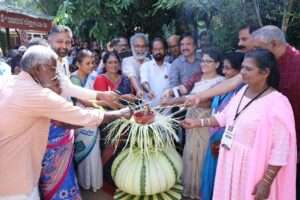

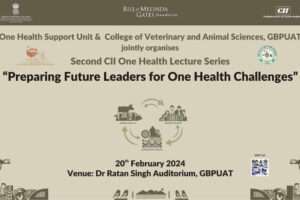
Add Comment